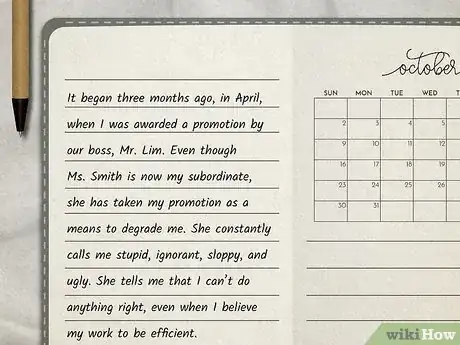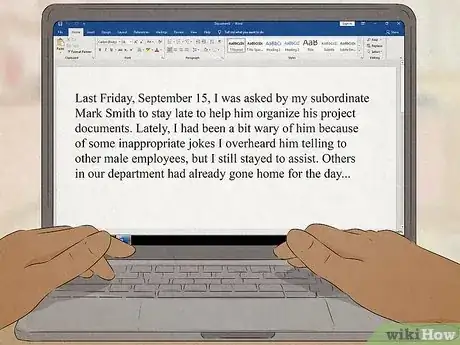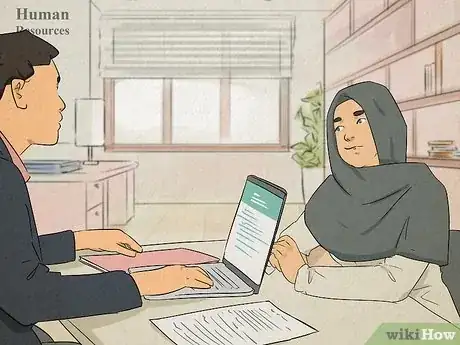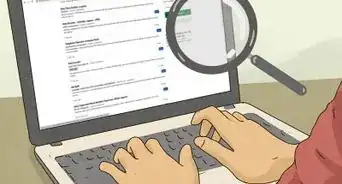This article was co-authored by Michael R. Lewis. Michael R. Lewis is a retired corporate executive, entrepreneur, and investment advisor in Texas. He has over 40 years of experience in business and finance, including as a Vice President for Blue Cross Blue Shield of Texas. He has a BBA in Industrial Management from the University of Texas at Austin.
This article has been viewed 270,552 times.
Our work and professional environments are a major part of our lives. However, sometimes an unstable, rude, or mean employee can disrupt workplace productivity, intimidate coworkers, and lead to potential legal or safety problems for a business. Unfortunately, dealing with aggressive and antagonistic behavior is challenging for any manager and many managers have problems disciplining their subordinates. However, if you communicate effectively, follow company procedures and document problems correctly, you'll be able to design and carry out a disciplinary plan without further issue.
Steps
Documenting Their Behavior
-
1Documenting specific acts that have caused problems. Make a specific record of complaints regarding the employee. In your documentation, include specific such as the nature of the incident, the employees/people involved, when the incident occurred, and the consequences. Even if the report is not placed in employee's file, proper documentation necessary to have objective, unemotional assessments of the employee's behavior.
-
2Assess their behavior. Evaluating their behavior will help you to gather evidence and document their behavior for use in implementing a disciplinary plan. When reviewing behavior, ask yourself several questions:
- Observations should be factual, not subjective. For example, don't use a term like "rude behavior", use "x" yelled, cursed, interrupted, walked away, etc.
- "Aggressive" is another subjective term that is not useful in an assessment.
- Finally, the manager probably doesn't know whether the employee has a personal problem or not until after the meeting.
Advertisement -
3Confirm the violation of company's policies. Employees should be corrected or disciplined when they break policy or fail to reach production standards, not because of attitude or style. Document the specific policy violated and how exactly the employee's actions violated it.
-
4Log the behavior. After you’ve evaluated the behavior and have decided to proceed, you’ll begin by documenting and logging their behavior. Logging the behavior will provide you with evidence to present to higher management and to the employee if your disciplinary plan is questioned. Make sure to:
- Include times and dates.
- Include locations.
- Include a detailed description of each incident and who reported/witnessed it.
Communicating With Your Subordinate
-
1Call an informal meeting. The first step you’ll have to take will be to schedule a meeting with the employee in question. This will provide you with the opportunity to troubleshoot issues with your subordinate and to determine if there is a larger problem going on.
- Approach your employee in person and tell them you need to speak to them.
- Avoid specifics. Don't say "I need to talk to you because your behavior is horrible lately."
- Speak calmly and clearly, leaving no doubt that the meeting is not optional.
- Avoid informing your employee where others can hear you.
- If for some reason you feel uncomfortable or threatened by the person in question, this is a different matter. In this case, the meeting should be handled by human resources.[1]
-
2Voice your concerns. After you've called a meeting with the employee, it will be time for you to voice your concerns. Make sure you do so properly. When talking with your subordinate:
- Detail the circumstances that caused the complaint without making a judgement and ask employee to confirm or explain the instance.
- Confirm that the actions violate company policy and that employee is aware of the violation.
- Be specific about what the problem is and how they should correct it.[2]
-
3Provide an opportunity for the employee to speak. After you've voiced your concerns, you will need to allow your employee to explain himself or herself. This is an important part, as you really need both sides of the story before making any decisions or moving further through the disciplinary process.
- Make sure to listen to what the employee has to say before passing judgment.
- Never assume the employee is a bad person. This will cloud your judgment of the incident.
- Do not pry into personal problems. If your employee starts to explain personal problems and suggests they are the root of their problem, hear them out, but do not pry.
- If you think your employee has explained himself or herself well enough, you can tell them, "I understand the situation now. I appreciate your information. If the circumstance arises again, please call me before it becomes a problem."
-
4Resolving the problem. If the employee doesn't have a justifiable reason for his action, changes and disciplinary action are necessary. Use the following process to resolve the problem:
- Make sure that the employee takes responsibility for his or her mistake and understands that their actions were unacceptable.
- Ask that the employee assure you that they are willing to change their behavior.
- Give them a detailed explanation of the standard of behavior expected from this point on.
- Finally, list consequences if the employee commits another violation of company policy.
-
5Work with HR to assess behavior issues. Contact the HR department if your company is large enough to have one. It may be tempting to ask other employees for input, but involving other people besides the perpetrator, the complainants, and the supervisor can make a mountain out of mole hill through gossip.
- Consult the individual’s employment records for information about previous problems with supervisors.
- If the person worked under another supervisor at your company, contact that supervisor.
- Do not divulge specific behavior to previous supervisors. Simply indicate that you are experiencing a problem with them and inquiry if they had the same experience.[3]
Implementing Disciplinary Action
-
1Confirm company policy. After you’ve formally documented and evaluated the insubordinate employee’s behavior, you should review company policy for specifics about the employee disciplinary policy. This is important, because without reviewing company disciplinary policy, you won’t know the exact steps you need to take to discipline the employee. Make sure to:
- Look at the employee manual (issued to each new employee) and review the employee disciplinary process as outlined in the manual. Reviewing the policy outlined in the employee manual or handbook will verify that the employee should know how discipline is dealt out.
- Consult your direct supervisor and let them know that you are about to begin disciplinary action.
- Consider your actions very carefully before proceeding, as an uncalled for disciplinary plan can open the company up to litigation and you to scrutiny from management.
-
2Contact the human resources department, if your company has one. Your company’s human resource department is designed to provide employees and management with support and guidance. As a result, you should be in constant contact with HR through the disciplinary process.
- Depending on your company’s policy, an HR representative may need to be present at all formal steps of the disciplinary process.
- Depending on your company’s policy, the disciplinary process may need to be implemented through HR.
- If your company does not have a Human Resources Professional, you may want to discuss a plan of action with your immediate supervisor or a Human Resources Consultant.[4]
-
3Establish a plan of disciplinary action. Based on your documentation, evaluation, and company guidelines, you should establish a plan of disciplinary action. Most company employee manuals use a version of a progressive disciplinary plan for addressing employee behavior or performance issues. Typical disciplinary plans include the following:
- Verbal discussion and warning.
- Written warning (up to three occurrences, depending on supervisor’s discretion).
- Termination.[5]
-
4Implement the disciplinary plan. After you’ve established a plan of action, you need to implement it. Implementations will begin with the first steps outlined in your plan.
- If this is the first time the employee has been disciplined, you may start with a verbal discussion and warning. The purpose of a verbal warning is to let the employee know that they are doing something that is not acceptable in the workplace. It's also an opportunity to resolve the situation.
- If this is the second time the employee has been disciplined, you will move on to a formal and written warning letter. In the warning letter, provide a short review of the past discussion and verbal warning. Then, clearly state the specific behavior or action leading to the written warning along with the date it occurred.
- If this is the third time (or more) the employee has been disciplined, you may move toward termination. If the employee's behavior has not improved after two (or more) warnings, termination should be considered.[6]
Expert Q&A
Did you know you can get expert answers for this article?
Unlock expert answers by supporting wikiHow
-
QuestionHow would I word statement when an employee says another is belittling them?
 Michael R. LewisMichael R. Lewis is a retired corporate executive, entrepreneur, and investment advisor in Texas. He has over 40 years of experience in business and finance, including as a Vice President for Blue Cross Blue Shield of Texas. He has a BBA in Industrial Management from the University of Texas at Austin.
Michael R. LewisMichael R. Lewis is a retired corporate executive, entrepreneur, and investment advisor in Texas. He has over 40 years of experience in business and finance, including as a Vice President for Blue Cross Blue Shield of Texas. He has a BBA in Industrial Management from the University of Texas at Austin.
Business Advisor When dealing with suspected acts of verbal harassment, it is important to document the exact circumstances of the harassment - with exact words used. Unfortunately, harassment is often a matter of perspective, not intent, and occurs without witnesses. Once you know the circumstances, you can decide how best to proceed.
When dealing with suspected acts of verbal harassment, it is important to document the exact circumstances of the harassment - with exact words used. Unfortunately, harassment is often a matter of perspective, not intent, and occurs without witnesses. Once you know the circumstances, you can decide how best to proceed. -
QuestionHow to deal with antagonistic independent disfributor who wont meet face to face?
 Michael R. LewisMichael R. Lewis is a retired corporate executive, entrepreneur, and investment advisor in Texas. He has over 40 years of experience in business and finance, including as a Vice President for Blue Cross Blue Shield of Texas. He has a BBA in Industrial Management from the University of Texas at Austin.
Michael R. LewisMichael R. Lewis is a retired corporate executive, entrepreneur, and investment advisor in Texas. He has over 40 years of experience in business and finance, including as a Vice President for Blue Cross Blue Shield of Texas. He has a BBA in Industrial Management from the University of Texas at Austin.
Business Advisor Independent distributors are not employees, but agents of the company whose actions and rights are documented in the distributor agreement. Check the agreement to determine the distributor is violating its terms. If so, you can void or threaten to void the agreement unless changes are made. If the distributor is complying with the agreement, you can either transfer him to someone else in the company or grow a thicker skin.
Independent distributors are not employees, but agents of the company whose actions and rights are documented in the distributor agreement. Check the agreement to determine the distributor is violating its terms. If so, you can void or threaten to void the agreement unless changes are made. If the distributor is complying with the agreement, you can either transfer him to someone else in the company or grow a thicker skin.
Warnings
- If your company does not have an employee manual or policies for fair employee treatment, it (and you) could be at greater legal risk for actions in hiring, managing and discipline of employees.⧼thumbs_response⧽
- If the employee's behavior is violent or creates a dangerous situation for the company or employees of the company, immediate termination should be considered. You should also consider involving law enforcement in violence is ever threatened.⧼thumbs_response⧽
References
- ↑ http://eli-leader.com/blog/having-hard-conversations-with-subordinates/
- ↑ http://eli-leader.com/blog/having-hard-conversations-with-subordinates/
- ↑ https://www.fairwork.gov.au/how-we-will-help/templates-and-guides/best-practice-guides/workplace-privacy
- ↑ https://www.higheredjobs.com/articles/articleDisplay.cfm?ID=461
- ↑ https://www.entrepreneur.com/article/79928
- ↑ https://www.entrepreneur.com/article/79928
About This Article
Having a rude, arrogant, and mean subordinate can be challenging, but if you remain professional and follow your company policy, you can get through it. If the employee's behavior is causing problems, document the specific incidents so you can report it. Make sure to include the dates and witnesses of the events. Remember to be objective and specific. For example, write, “Dan yelled, cursed, and interrupted me several times.” In the first instance, call the employee to a private and informal meeting. Calmly explain their specific behaviors and the consequences if they continue to act unprofessionally, according to your company policy. If your company has a Human Resources department, keep them in the loop about your disciplinary action. If the employee continues to act unprofessionally, follow procedure to discipline or fire them. For more tips from our Business co-author, including how to establish a plan of disciplinary action, read on!









































































